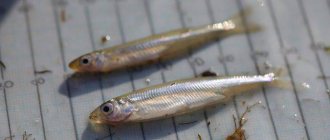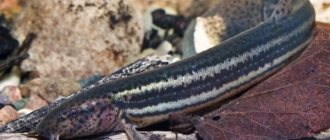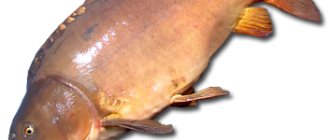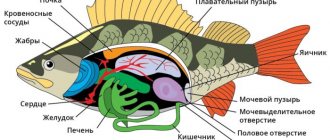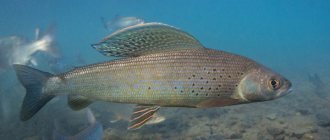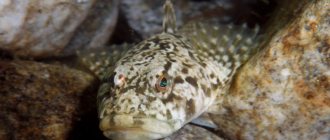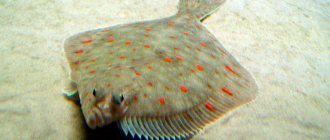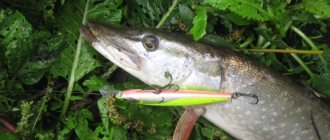Lenok
(from Latin Brachymystax) is a freshwater fish of the Salmon family, living in the foothills of rivers and cold mountain lakes. Distributed in rivers of the Far East and Siberia, Mongolia, China, and Western Korea. Recorded in large tributaries of the Yenisei - Sisima, Tube, Angara, Kane, Nizhnyaya Tunguska. In Russia, it lives in rivers from the Kolyma to the Ob, as well as in rivers that flow into the Sea of Japan and Okhotsk, for example, in the Amur.
Lenok is a fairly large freshwater fish. In the literature it is also called Siberian trout. Externally, lenok fish resembles salmon and whitefish. Her body is torpedo-shaped. Lenok's scales are quite small. The color is red-brown with different shades depending on the habitat. Lenok is a predator. The fish has a fairly small mouth. But at the same time, he is armed with teeth and fangs that will not miss even large prey. The average weight of an individual is about 2 kg, but some fish reach 8 kg. Lenok lives up to 14 years.
Description
Lenok
Kingdom:
animals (Animalia)
Phylum:
chordates (Chordata)
Class:
ray-finned fishes (Actinopterygii)
Order:
salmonids (Salmoniformes)
Family:
salmonids (Salmonidae)
Genus
lenok (Brachymystax)
Species:
lenok (Brachymystax lenok)
Lenok is a predatory freshwater fish from the salmon family. It also has other names: Siberian trout, limba (Yakut), maygun (Evenki) and uskuch (Turkic). It has 2 main forms: sharp-snouted and blunt-snouted. Externally, the body shape is a bit like a whitefish. The body is slab-shaped and has a small mouth, short sharp teeth and small dense scales. Reaches a length of 90 cm and a weight of 6.5 kg, the average dimensions correspond to a five-year-old individual and are 40 cm and 0.9 kg, respectively. Lives up to 15 years. The color of the lenka is determined by the age of the fish and its habitat conditions. The adult individual is dark brown and golden in color with many round dark spots, and the belly is light. During spawning, red spots appear. It has 2 fins on its back, both with spots. The lower front fins have a distinct white edge. A young immature lenok (hare) has a silver color, a gray back and yellowish fins. The law prohibits recreational and commercial fishing of hare.
There are two subspecies of lenok: blunt-snouted and sharp-snouted. Most likely, they were formed due to the preferred way of eating. The blunt-snout has a terminal mouth, which means it feeds in the middle layers of the reservoir. The sharp-snout has a slightly longer upper jaw and a semi-lower mouth, which means that it devotes some of its time to bottom feeding. The body of this fish is slanted, torpedo-shaped, with small scales, dark green at the back and dark golden or silver with small black spots on the sides. The tail has a small adipose fin, like all fish of the salmon family.
Scientific classification of the species:
- Kingdom: Animals (lat. Animalia)
- Type: Chordata (lat. Chordata)
- Subtype: Vertebrata (lat. Vertebrata)
- Group (Infratype): Gnathostomes (lat. Gnathostomi)
- Superclass: Pisces (lat. Pisces)
- Class: Bony fish (lat. Osteichthyes)
- Group: New-finned fish (lat. Neopterygii)
- Infraorder: Bony fish (lat. Teleostei)
- Superorder: Protacanthopterygii (lat. Protacanthopterygii)
- Order: Salmoniformes (lat. Salmoniformes)
- Family: Salmonidae (lat. Salmonidae)
- Species: Lenok (lat. Brachymystax lenok)
Rarity category:
1 - a group of populations of the blunt-snouted lenka form that is on the verge of extinction.
Population:
river basin Obi
Spreading:
The species is widespread in the rivers of Siberia, the Far East, China, Mongolia and Korea; is represented by sharp-snouted and blunt-snouted forms, which some researchers distinguish as independent species. In the bass. The Ob River on the territory of Russia is home to a morphologically and genetically unique group of populations of the blunt-nosed lenok, isolated from the rest of the range of this form (the Lena basin and to the east of it). Lenki bass. The Ob inhabits the reservoirs of the Altai Mountains (basin river Biya, including Lake Teletskoye, and Katun), the upper reaches of the river. Chulym and, possibly, r. Tomi. In the 19th and early 20th centuries. the lenok reached along the Upper Ob to Barnaul; Currently, the border of the range has retreated to the upper reaches, where exactly it lies is unknown, but, apparently, much higher upstream the confluence of the river. Biya and Katun, whose populations became isolated. In the bass. Over the past decades, Katun has disappeared from the largest lakes of the Katun Range, where it was previously common. Habitat in Charysh is doubtful. Modern distribution in the bass. Chulym and Tom have not been studied; perhaps there are several scattered small populations in the very upper reaches of individual rivers.
Lenok habitats:
Freshwater fish, an inhabitant of clear mountain and foothill rivers with fast currents, is also found in lakes. In Lake Teletskoye Individuals up to 75 cm long and weighing up to 4.6 kg and even 6-8 kg, at the age of up to 13 years, have been recorded. Spawns in rivers (from Lake Teletskoye it rises into tributaries) in May-early June on rocky and pebble soils. Fertility is up to 14.5 thousand eggs (in a female weighing 3.6 kg), minimal (in the smallest females), about 2 thousand eggs. The eggs are yellow, up to 4.5 mm in diameter, after fertilization and swelling - 5-5.5 mm. Development of eggs in soil at 8-9°C takes 23-25 days. Polyphagous, feeds on aquatic insect larvae (caddisflies, stoneflies, chironomids, dragonflies), amphipods, mollusks, leeches, worms, aerial insects, fish, frogs, voles, shrews.
Lifestyle
The lifestyle of the lenka is reminiscent of the lifestyle of taimen and grayling.
Lenok, being a hare, stays in a flock in shallow reaches, in channels, rifts and bays, and the larger individual loves mountain rivers with deep reaches and rifts. The adult prefers solitary rather than gregarious life. Male flax reaches puberty at the age of 5-8 years, female – at 6-9 years. Reproduction occurs in May - June at a water temperature of 3-6 degrees Celsius in the upper reaches of large rivers and lakes, in springs and tributaries with a rocky bottom and a fast current 0.5-1.5 m from the water surface. After spawning, the lenok gradually slides downstream to deep areas, where it overwinters. Lenok fish
Lenok is sensitive to the oxygen state of the reservoir and loves clean, cold water. Prefers to live in rivers with a medium current. With soil consisting of pebbles, stones or coarse sandstone. Loves lakes with flowing or semi-flowing water, with a decent food supply. Lives only in fresh water. Most active in the early morning and at sunset.
Nutrition
Lenok
- a predatory fish, juveniles first feed on zooplankton, then on small organisms living on the bottom. An older individual eats the larvae of various insects, these can be stoneflies, mayflies, caddisflies, dragonflies, grasshoppers, as well as algae, amphipods, small mollusks, earthworms, caviar and juveniles of other fish (minnow, minnow, sculpin, dace, perch and grayling ). Large individuals of lenok can even swallow a mouse, shrew or frog. Lenok feeds most actively in the mornings and evenings.
Spawning
It reaches sexual maturity at 5-6 years of age. To reproduce, it goes to the upper reaches of rivers, enters streams and small clean channels. Selects a bottom with stones or pebbles, with a fairly strong current. This fish spawns at water temperatures from 3 to 7 degrees, almost always after the ice melts on reservoirs. The eggs are 3-4 mm in diameter, fertility ranges from 6 to 12 thousand eggs.
At this time, the color of the scales becomes more saturated and bright, reddish spots become visible, barely noticeable at other times. After spawning, the lenok remains in the same reservoir for feeding after a hunger strike. The young emerge from the eggs after a month, sometimes after a month and a half. After a month, the fry, which has grown to 2 cm, actively eats and by autumn moves to deeper places. In general, lenok grows quite slowly.
Description and development features
Lenok belongs to the salmon genus. Its body shape is very similar to a whitefish, but its scales are smaller and denser. The color of the body changes from golden to brown. In addition, darker spots may be located on the back and abdomen. During spawning, red stripes appear on the sides. The length of an ordinary individual rarely exceeds 50 centimeters, but some fishermen managed to catch individuals whose length exceeded 1 meter. On average, representatives of this species live no more than 4 years. By this time, the average weight of the fish is usually no more than 4 kilograms. In some sources you can find information that the maximum age of a caught individual reaches 14 years.
Lenok nutrition and diet
The diet of this species depends on age. Thus, small fish feed mainly on insects and plankton. With age, small fish and crustaceans are added to the diet. During this period, the lenok feeds like taimen. After reaching 3 years of age, the lenok switches to larger prey. It can hunt small fish and insects, as well as small frogs and even mice that come close to the water. Experts say that individuals are ready to hunt around the clock , but the peak of activity occurs in the morning and night hours. Some fishermen say that early in the morning you can listen to the flax moving in shallow water in search of prey.
Reproduction and maturation of individuals
The average representatives of this species are ready to breed at the age of 3 years. Moreover, readiness for spawning does not depend on the size of the fish. Thus, scientists met in some reservoirs adult individuals whose weight did not exceed 400 grams. This is due to the small amount of feed.
Preparation for spawning in this species begins in early spring. Fish rise up the rivers. Females choose places with a strong current and a pebble bottom. The spawning process begins at the end of May. On average, each female can lay from 6 to 14 thousand eggs. After this, the individuals begin to actively feed, but do not move far from the spawning sites. Two weeks after spawning, adults begin to swim down the river.
Maturation of the fry lasts up to 30 days, but they begin to actively move only a month after emerging from the larvae. The average length of a month-old fry is 2 centimeters. The fry gather in small schools and feed on plankton. They begin to descend along the river in early autumn.
Fishing for lenka
Lenok fish
Lenka is caught after the end of spawning until late autumn at dawn and in the evenings. In the summer heat, the lenok moves chaotically and can accidentally swim into the mouth of a cold tributary, into a quiet backwater, or bay. In cool weather during the day, lenok gathers in reaches, holes and creases, and at night it feeds on riffles and channels, and is found in shallows near the shore.
On narrow rivers, lenok is usually caught from the bank with fly fishing, on wide rivers - with a spinning rod from a boat, and it is worth remembering that lenok usually lives next to taimen, a strong and large fish, so you need to choose strong tackle. It is better to select the nozzle and weight so that it moves near the bottom. The bait can be: pieces of fish, worms, insects and their larvae, as well as artificial bright sinking flies and spoons. Lenok prefers spinners that are oscillating, up to 55 mm long, up to 2.5 mm thick, triangular, weighing 20-30 grams, spinning up to 40 mm long. The hook should be large; treble hooks are placed with numbers 8,9 and 10, masking them with bright threads. Lenok is usually caught by the chin, because... tries to press the bait to the bottom of the reservoir. The fishing line is usually chosen with a thickness of 0.5-0.6 mm, a leash - 0.3-0.4 mm
The lenka bite is fast, like a trout. Fishing is quite troublesome - the lenok moves the line in different directions, jumps out of the water, somersaults and hides, so in order to avoid the lenok falling off the hook, fishermen try to go into the water in the shallows and bring the fish behind their backs. When the flax gets tired of fighting, they try to throw it further ashore. In a boat, the struggle looks about the same - we put the bit behind our back, lower it into the boat, take the fishing line with our hands and pull out the fish.
For a successful catch, the fisherman should take certain points into account. Firstly, lenok is a fairly cautious fish. Therefore, it makes no sense to catch it in one place for a long time. Feeling threatened, the lenok goes to another place. Secondly, once the fish is hooked, under no circumstances should it be allowed to go into the bushes. Otherwise, a breakdown of the lenka is inevitable. It is necessary that the line is always taut. There is no need to relax ahead of time. Even close to the shore, a lenok can break loose. But experienced fishermen know that this is not a fiasco at all. A tired fish lies motionless near the shore for some time. Therefore, with some skill, you can catch it with your hands.
Methods of catching sea lenka
When fishing for sea lenka, you should take into account its lifestyle. The main methods of amateur fishing can be considered fishing with various equipment for vertical fishing. Provided that lenka can be caught with both natural and artificial baits, it is possible to use various rigs of the “tyrant” type, where simply pieces of bright fabric or pieces of meat are attached to the hooks. In addition, fish react to various silicone baits and vertical spinners. Terpugs are also caught using spinning gear when fishing “casting”, for example, from the shore.
Catching sea lenka with a “tyrant”
Fishing with “tyrant”, despite the name being clearly of Russian origin, is quite widespread and is used by fishermen all over the world. There are slight regional differences, but the fishing principle is the same everywhere. It is also worth noting that the main difference between the rigs is most likely related to the size of the prey. Initially, the use of any fishing rods was not envisaged. A certain amount of cord is wound onto a reel of arbitrary shape; depending on the fishing depth, this can be up to several hundred meters. A sinker with a corresponding weight of up to 400 g is attached to the end, sometimes with a loop at the bottom to secure an additional leash. Leashes are attached to the cord, most often in the amount of about 10-15 pieces. Leashes can be made from materials depending on the intended catch. This can be either monofilament or metal leader material or wire. It is worth clarifying that sea fish are less “picky” about the thickness of the rigs, so you can use fairly thick monofilament lines (0.5-0.6 mm). Regarding the metal parts of the equipment, especially the hooks, it is worth keeping in mind that they must be coated with an anti-corrosion coating, because sea water corrodes metals much faster. In the “classic” version, the “tyrant” is equipped with baits with attached colored feathers, woolen threads or pieces of synthetic materials. In addition, small spoons, additionally attached beads, beads, etc. are used for fishing. In modern versions, when connecting parts of equipment, various swivels, rings, etc. are used. This increases the versatility of the tackle, but can harm its durability. It is necessary to use reliable, expensive fittings. On specialized vessels for tyrant fishing, special on-board devices for reeling in tackle may be provided. This is very convenient when fishing at great depths. If fishing takes place from ice or a boat on relatively small lines, then ordinary reels that can serve as short fishing rods are sufficient. When using onboard fishing rods with guide rings or short sea spinning rods, a problem arises on all multi-hook rigs with “selecting” the rig when landing fish. When catching small fish, this problem is solved by using rods with guide rings 6-7 m long, and when catching large fish, limiting the number of “working” leads. In any case, when preparing gear for fishing, the main theme should be convenience and simplicity during fishing. A “tyrant” is also called a multi-hook rig using natural baits. The principle of fishing is quite simple: after lowering the sinker in a vertical position to a given depth, the fisherman makes periodic twitches of the tackle according to the principle of vertical trolling. In the case of active biting, this is sometimes not required. “Landing” of fish on hooks can occur when lowering the equipment or from the rocking of the vessel.
Composition and beneficial properties of lenka
Lenka meat contains essential fats and proteins, as well as vitamin PP, which has a beneficial effect on the nervous system, improves blood flow and helps eliminate toxins from the body. In addition, lenok contains a number of microelements: chromium, which accelerates metabolism and regulates blood glucose levels, zinc, necessary for the functioning of the gastrointestinal tract and kidneys, fluorine, which affects the condition of bone tissue, nails, hair and teeth, as well as molybdenum and nickel .
Lenok is a fish of the salmon family, so its caviar, although small, is very high in calories and contains a large amount of amino acids, which are easily absorbed in the body. This caviar contains almost the entire range of fat-soluble vitamins. Another advantage of this product is its easy and rapid absorption in the intestines, so it is recommended for use by weakened people who have suffered serious illnesses and surgeries and who cannot eat “heavy” foods.
Lenka meat has no obvious contraindications for consumption, however, people with individual intolerance to seafood and allergic reactions to fish should be extremely careful.
